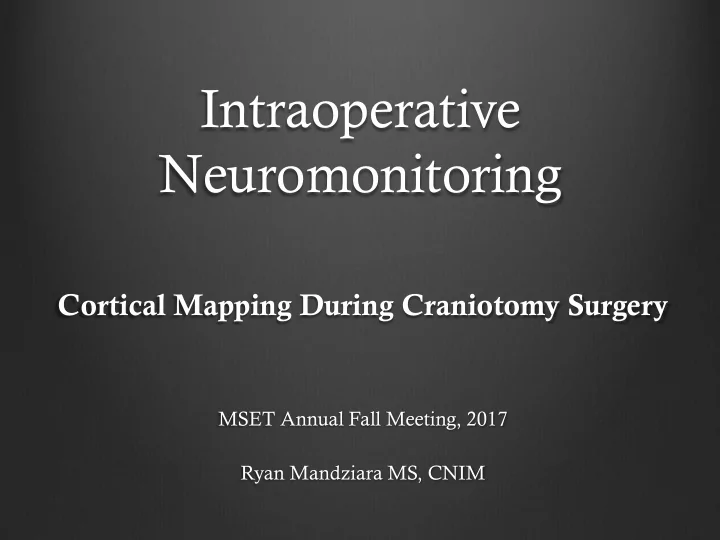

Intraoperative Neuromonitoring Cortical Mapping During Craniotomy Surgery MSET Annual Fall Meeting, 2017 Ryan Mandziara MS, CNIM
Neuromonitoring Overview What? Application of neurophysiologic modalities to monitor the functional integrity of neural structures during surgery Why? Prevention of Iatrogenic injury and functional guidance When? Neuro-, Orthopedic-, Vascular and ENT Surgery How? SSEP, TCeMEP, EEG, EMG, BAEP, NAP, Mapping
Intraoperative Neuromonitoring Methods Sensory Monitoring -Dorsal Column Tract (Afferent) / Primary Somatosensory Cortex -Evoking and Recording Methods Motor and Muscle Monitoring -Corticospinal Tract (Efferent) / Primary Motor Cortex -Evoking and Recording Methods Combined approach to Cortical Mapping Anesthesia Protocol Case Study
Dorsal Column Pathway Pons Medulla Cord Watt, J. (2016). SSEP Pathway, Waveforms and Generators. Retrieved from http://neurodiagnosticsolutions.com/course/view.php?id=2
MN Stimulation Results in Depolarization of Lateral SS Cortex PTN Stimulation Results in Depolarization of Medial SS Cortex Watt, J. (2016). SSEP Pathway, Waveforms and Generators. Retrieved from http://neurodiagnosticsolutions.com/course/view.php?id=2
Cortical SSEP Responses are Recorded from Subdermal needle electrodes placed according to 10-20 System v A sufficient number of repetitions must be averaged to produce an interpretable and reproducible SSEP. Generally 250 – 1000 repetitions are needed; the number of repetitions depends on the amount of noise present and the amplitude of the SSEP signal itself (signal to noise ratio). ACNS Guideline 11B https://www.researchgate.net/figure/267306345_fig2_Figure-4-International-10-20-system-electrode-position
SSEP Responses are collected during surgery from peripheral, Subcortical and cortically placed leads. Fpz L EP R EP v The first number/letter combination CP3 Cpz CP4 represents the actively recording lead and the second represents the CS3 reference recording lead
Each peak and trough is designated by a letter/number combination. The letter P for positive, N for negative describes the polarity of the response (A Negative signal results in upward deflection, and a Positive signal results in downward deflection) So is there a net movement of electrons toward or away from the recording electrodes The number indicates the latency in milliseconds after stimulus presentation.
Intraoperative Neuromonitoring Methods Sensory Monitoring -Dorsal Column Tract (Afferent) / Primary Somatosensory Cortex -Evoking and Recording Methods Motor and Muscle Monitoring -Corticospinal Tract (Efferent) / Primary Motor Cortex -Evoking and Recording Methods Combined approach to Cortical Mapping Anesthesia Protocol Case Study
Corticospinal Tract Figure 1.2. Adapted from Neuroanatomy, An Illustrated Colour Text, 4 th Ed (Page 37), A. R.Crossman, D.Neary. Elsevier Publishing, 2010.
C3 and C4 Positions used to Evoke MEPs using Anodal Electrical Stimulation C3 Anode Anode v C4 v = Right Side Motor = Left Side Motor Responses Responses C4 v C3 v
Motor Evoked Potentials Generated over Motor Cortex and Recorded in all extremities
Intraoperative Neuromonitoring Methods Sensory Monitoring -Dorsal Column Tract (Afferent) / Primary Somatosensory Cortex -Evoking and Recording Methods Motor and Muscle Monitoring -Corticospinal Tract (Efferent) / Primary Motor Cortex -Evoking and Recording Methods Combined approach to Cortical Mapping Anesthesia Protocol Case Study
https://upload.wikimedia.org/wikipedia/commons/thumb/f/fe/Medulla_spinalis_-_tracts_-_English.svg/2000px-Medulla_spinalis_-_tracts_-_English.svg.png
Central Sulcus Primary Motor Cortex (Post. Frontal Lobe) Primary Sensory Cortex (Ant. Parietal Lobe)
3D rendering Axial MRI with DTI Tumor +DTI Reconstruction Sagittal MRI Coronal MRI with Tumor With DTI Reconstruction
Median Nerve SSEP Stimulation to Record Phase Reversal at Central Sulcus Watt, J. (2016). SSEP Pathway, Waveforms and Generators. Retrieved from http://neurodiagnosticsolutions.com/course/view.php?id=2
https://assets.ysjournal.com/wp-content/uploads/2016/04/brain-990x622.png
Post. Ant. http://pediatricsnationwide.org/2016/10/18/in-sight-two-stage-surgery-for-epilepsy/
Phase Reversal Theory Dipole Characteristic of Brodmann’s Area 1, 3a, 3b. Advanced IONM, Brain Mapping Presentation, Gertsch (2017) ASET Annual Conference
https://assets.ysjournal.com/wp-content/uploads/2016/04/brain-990x622.png
ECoG Electrical Stimulation
Resection of Frontal Lobe Tumor Areas Involved in upper and lower extremity motor function are discovered using the mapping technique described. Tumor resection (anterior to “Hand” and Lleg ” markings) may be conducted with new motor deficit being unlikely.
Subcortical Stimulation http://www.en.inomed.com/fileadmin/_processed_/csm_Anwendung_Mappin gsauger_2_web_e203b88c15.jpg
Subcortical Stimulation Patients whom subcortical MEPs were recorded, the mean stimulus intensity was 10.4 ± 5.2 mA and the mean distance from the probe tip to the corticospinal tract (CST) was 7.4 ±4.5 mm. There was a trend toward worsening neurological deficits if the distance to the CST was short (<5mm), and a small minimum stimulation threshold was recorded. ( 1mA : ~1 to 1.5mm)
Sample Anesthesia Technique Induction 0.5 μ g/kg sufentanil, 2 mg/kg propofol, 2 mg midazolam, 20 mg pepcid, and 0.6 mg/kg rocuronium (a very short-acting muscle relaxant) are initially used. Scalp Block approximately 30 ml of 0.5% ropivacaine with epinephrine in a 1:200,000 ratio to the greater/lesser occipital, auricular-temporal, zygomatic-temporal, V1, and supratrochlear nerves, respectively. Maintenance 50 μ g/kg/min propofol, 0.05 μ g/kg/min remifentanil, approximately 0.5% – 0.6% isoflurane, and 50% oxygen/50% air. No additional muscle Relaxants used during surgery.
Case Study
Recommend
More recommend